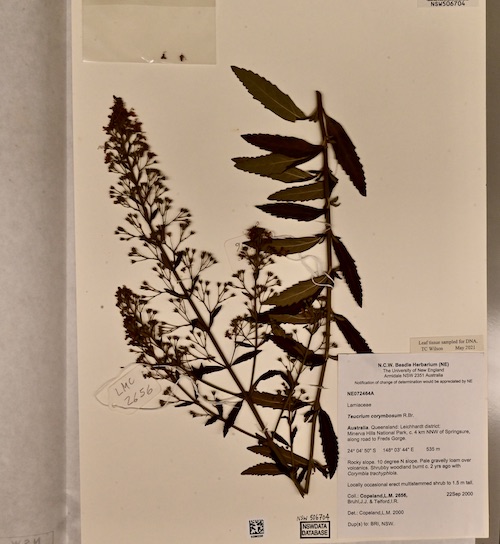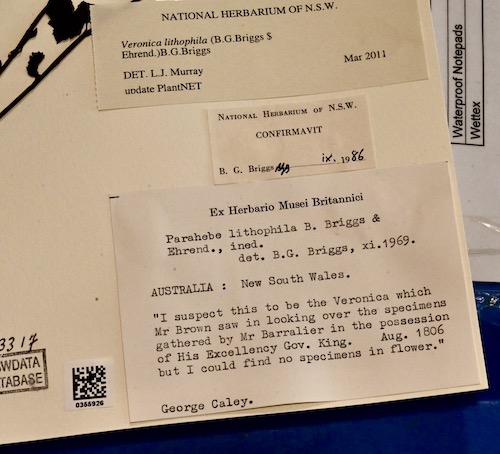When Captain Cook sailed along the east coast of Australia in 1770 his merry band of collectors loaded the Endeavour with a very large plant collection. So, what happened to the 800 specimens that Joseph Banks and Daniel Solander collected? Over the past 250 years these specimens together with many others that the thousands of botanists collected have eventually ended up in large publicly funded herbariums.
The old Sydney Herbarium in the Royal Botanic Garden held over 1.4 million plant specimens and was growing. It had some of the 1770 Banks and Solander specimens. Unfortunately, the old Herbarium was bursting at the seams and many of the 75,000 red specimen boxes were infested with tissue-eating bugs. Toxic napthalene, besides killing the insects, was poisoning the botanists. The only way to control the insects was to store the specimens at below 16C.
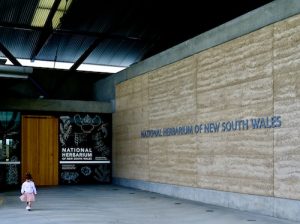
To solve the insect and space problem a new 60 million dollar herbarium has been built at Mount Annan in south western Sydney. It is next to the seed and tissue culture bank (Australian PlantBank) built in 2013. The new herbarium has been designed as a state-of-the-art scientific facility able to accommodate the entire plant collection far into the future at below 16C. It also has two DNA laboratories, drying and freezing rooms and plant mounting workshops. Each area is rigorously quarantined to protect the specimens from infections and insects.
Mounted specimens are kept in hundreds of draws in large compactus shelving units in six separated cooling vaults. Each vault has its own complex heating, ventilation and air conditioning system. From the outside we see six rammed earth walls that produce a natural looking structure that uses very little energy to heat or cool. These walls produce a thermal stability like being inside a cave. The excavation site produced the 2,100 tonnes of earth for the vault walls. They sit on a thick concrete slab to protect the collection against fire and extreme temperature events. A metal fly roof protects the concrete slab on top of the rammed earth walls.
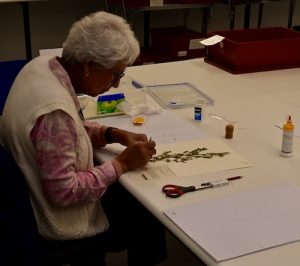
Moving the collection from the Royal Botanic Garden to Mount Annan was a mammoth task. In October 2022 collections manager Hannah McPherson explained how the move was achieved. Dr Hannah McPherson who is a biodiversity genetics research scientist led our group of 10 from the Northern Beaches Australian Plants Society through the facility. She explained that the first task was to digitally photograph the entire collection with high resolution images that are now available on the internet. Specially equipped removalists transported 75,000 red specimen boxes to Mount Annan where they were frozen to kill insects and disassembled into the compactus drawers. Specimens have now been placed in the order of today’s accepted botanical research, however the versatility of the storage system allows this ordering to be easily changed. This order tells the story of evolution now enhanced by DNA research.
We met Peter Jobson who is in charge of the publicly available plant identification service. Peter explained that although licenced scientists collect many of the plant specimens that arrive at the herbarium a significant number come from the public. They become a permanent record in the herbarium, providing invaluable data on the distribution and ecology of our flora. Peter also explained that while photographs may be useful for identification a voucher (i.e. the documented specimen) must be a physical specimen with a description of location, soil type and ecological environment. A group of volunteers mount these vouchers with glue, linen tape and dental floss onto archival paper. The voucher is frozen and stored in a compactus to become a permanent record in the herbarium. This data has contributed to resources such as NSW FloraOnline (PlantNET), the Australasian Virtual Herbarium and the Atlas of Living Australia.
Hanna took us into the cold vaults to see a compactus with voucher folders safely stored in drawers. In the study area next to the open vault two scientists were accessing the vouchers. Both scientists were examining records from the past to describe the botany of NSW. Dr Trevor C. Wilson, an ABRS Postdoctoral Fellow, was doing research on the mint family (Lamiaceae). Dr Barbara G. Briggs AM, Honorary Research Associate in Systematic Botany, was examining a voucher of Veronica lithophila that Francis Barralier had collected in the Burragorang River valley in his failed attempt to cross the Blue Mountains in 1802. This voucher had come back to Australia from London to enhance the Sydney herbarium collection. Robert Brown had taken it to London in 1805 where he studied his enormous collection.
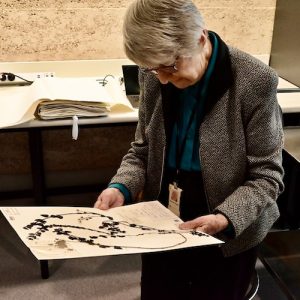
Barbara’s illustration of this plant drew our attention to the importance of maintaining original specimens. This specimen had been examined by the significant botanists Robert Brown 1806 and George Caley who called it Veronica lithophila. Barbara had collected a specimen in the Grose River valley growing on a rock shelf in 1967 and in 1986 called it Parahebe lithophila. When re-examined in 2007 and compared with the Francis Barralier specimen Barbara renamed her Grose River valley specimen its original name, Veronica lithophila. This was necessary because Francis Barralier’s 1802 specimen had become the holotype – the single specimen designated as the type of a species by the original author at the time the species name and description was published. Robert Brown named the specimen that he saw Veronica because Carl Linnaeus had given a common European plant the name Veronica. Quite a few European Veronicas have been naturalised in Australia and may be weeds however the saved herbarium specimen proves that these plants were in Australia before European settlement.
Barbara is a doyen of Australian botany having been employed at the Royal Sydney Botanic Gardens since 1959. She has published 205 plant names and received many scientific awards. She has been instrumental in the ordering of flowering plant species based on their evolution. This order governs the specimen arrangement in the herbarium’s collection. We felt privileged to meet and receive Barbara’s attention.
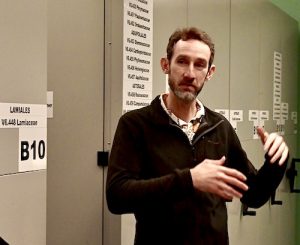
Dr Trevor C. Wilson who also specialises in systematic botany and population genetics is presently studying Australian Ajugoideae, a subfamily of the mint bush family (Lamiaceae). Trevor spoke to the group in July when he described his review the taxonomy of the Ajuga australis species. He has been using DNA analysis to sort out the conundrum of whether mints called Ajuga australis is one or a number of species. DNA has been extracted from specimens in the herbarium although recent collections have been more fruitful for DNA analysis. I found a Teucrium corymbosum specimen that Lachlan Copeland had collected in 2000 that Trevor sampled for DNA in 2021.
Our day at the herbarium was more than viewing a facility for filing in cold storage.
We were grateful to Hanna, Peter, Barbara and Trevor for generously giving their time for us to take a journey into the past, broaden our botanical knowledge and to make many discoveries.
Herbarium Public Data Set available on the internet
